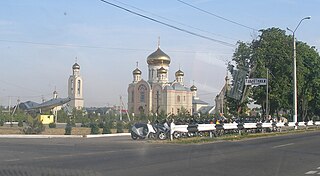Keretapi Tanah Melayu Berhad (KTMB) or Malayan Railways Limited, colloquially referred to simply as KTM, is the main rail operator in Peninsular Malaysia. The railway system dates back to the British colonial era, when it was first built to transport tin. Previously known as the Federated Malay States Railways (FMSR) and the Malayan Railway Administration (MRA), Keretapi Tanah Melayu acquired its current name in 1962. The organisation was corporatised in 1992, but remains wholly owned by the Malaysian government.

The rail network in Adelaide, South Australia, consists of four lines and 89 stations, totalling 132 km (82 mi). It is operated by Keolis Downer under contract from the Government of South Australia, and is part of the citywide Adelaide Metro public transport system.

The Canada Dock Branch is a 4-mile 59 chain long railway line in Liverpool, England. The line's route is from the large Edge Hill rail junction in the east of Liverpool to Seaforth Dock to the north. The line was originally built by the London and North Western Railway terminating at Canada Dock, with a later branch extension added to Alexandra Dock and links onto the MDHC railway lines. The line is not electrified.

Elektrichka is a Soviet and Eastern bloc commuter (regional) mostly suburban electrical multiple unit passenger train. Elektrichkas are widespread in Russia, Ukraine and other countries of the former Warsaw Pact presenting a socially vital mode of transportation. In 2007, 4085 commuter trains a day were running on the Russian Railways network alone, most of them electric. The first elektrichka train on July 6, 1926, along the Baku–Sabunchi line in Soviet Azerbaijan. Also urban (intra-city) gorodskaya elektrichkas and airport's aeroexpresses exist in a few cities of Russia, Ukraine, and Belarus.

Ukrainian Railways or Ukrzaliznytsia (UZ) (Ukrainian: Укрзалізниця) is a state-owned joint-stock company administering railway infrastructure and rail transport in Ukraine; a monopoly that controls the vast majority of the railroad transportation in the country. Ukrainian Railways is the world's sixth largest rail passenger transporter and world's seventh largest freight transporter. As of 2020, the total length of the main broad-gauge (1,520 mm) railroad network was 19,787 kilometres (12,295 mi), making it the 13th largest in the world. Ukraine also has many stretches of standard-gauge railway (1,435 mm), and is currently working to expand these in order to improve its connections to the European Union.

Rail transport in Ukraine is a major mode of transport in Ukraine. Most railway infrastructure in Ukraine is owned by the government of Ukraine through Ukrzaliznytsia, a joint-stock company which has a de facto country-wide monopoly on passenger and freight transport by rail.

South East Queensland has a large passenger and freight railway network centred on Brisbane, the capital city of the Australian state of Queensland. Suburban and interurban passenger services in the region are operated by Queensland Rail, which also operates long-distance trains across the state. Aurizon and Pacific National operate freight services.

JSC Latvian Railway was established on 2 September 1991. It is seen as the successor of the Latvian State Railways company which was established on 5 August 1919 and dissolved by the Soviet occupation of Latvia in 1940.

Southwestern Railways (PZZ), headquartered in Kyiv, the capital of Ukraine, is a component part of the Ukrzaliznytsia company, its regional branch.
Rail transport in Djibouti is administered through the Ethio-Djibouti Standard Gauge Rail Transport Share Company, a bi-national company between Ethiopia and Djibouti to manage the only railway in Djibouti, the electrified standard gauge international Addis Ababa–Djibouti Railway. This railway opened on 1 January 2018 replaced the international metre gauge railway from Djibouti's capital Djibouti City to the Ethiopian capital Addis Ababa, which was officially decommissioned in 2016.

Calea Ferată din Moldova is the sole railway operator in the Republic of Moldova, responsible for passenger and cargo transportation, as well as railway infrastructure maintenance within the country. The total length of the network managed by CFM is 1,232 kilometres (766 mi), of which 1,218 kilometres (757 mi) are 1,520 mm, and 14 kilometres (8.7 mi) are 1,435 mm. The entire network is single track and is not electrified. It borders the Romanian railway network, with a 1,520 mm /1,435 mm break-of-gauge in the west, and the Ukrainian one in the east.

The State Railways of the Republic of Turkey, abbreviated as TCDD, is a government-owned national railway company responsible with the ownership and maintenance of railway infrastructure in Turkey, as well as the planning and construction of new lines. TCDD was formed on 4 June 1929 as part of the nationalisation of railways in Turkey.

Alsancak railway station is one of the two main railway terminals in İzmir and is the second-oldest railway station in Turkey, after Kemer, being completed in 1858. The station is the main hub for İZBAN trains, and is the terminus for both lines.

Cisdnieper Railway(Ukrainian: Придніпровська залiзниця, romanized: Prydniprovska zaliznytsia ) is a regional operator of Ukrainian Railways in the south of Ukraine with headquarters in Dnipro city.

Tiraspol railway station is a railway station in the city of Tiraspol, capital of the de facto state of Transnistria, recognised internationally as part of Moldova. It has both passenger and freight facilities, including a capacity for border control by the Transnistrian authorities.
Pidhorodna is an urban-type settlement in Pervomaisk Raion, Mykolaiv Oblast, Ukraine. It belongs to Pervomaisk urban hromada, one of the hromadas of Ukraine. Population: 2,150.

Velyka Mykhailivka is a rural settlement in Rozdilna Raion in the west of Odesa Oblast, Ukraine. It hosts the administration of Velyka Mykhailivka settlement hromada, one of the hromadas of Ukraine. Velyka Mykhailivka previously served as the administrative center of Velyka Mykhailivka Raion. Population: 5,303

Avanhard is a rural settlement in Odesa Raion, Odesa Oblast, Ukraine. It is a western suburb of the city of Odesa and is adjacent to the city. Avanhard hosts the administration of Avanhard settlement hromada, one of the hromadas of Ukraine. Population: 7,435.
Radisne is a rural settlement in Berezivka Raion of Odesa Oblast in Ukraine. It is located on the right bank of the Malyi Kuialnyk. Radisne belongs to Znamianka rural hromada, one of the hromadas of Ukraine. Population: 1,496
Khlibodarske is a rural settlement in Odesa Raion, Odesa Oblast, Ukraine. It is essentially a western suburb of the city of Odesa. Khlibodarske belongs to Avanhard settlement hromada, one of the hromadas of Ukraine. Population: 2,555.

















